
Read below about how to make and use your own class sign-in book for name writing practice. Free printable preschool sign in sheets included at the end of the post.
Names are the . . . well, name . . . of the game in preschool! To get the kids started, I’m a big believer in using hands-on, multi-sensory activities to teach kids about their names.
And lots of fine motor practice, of course, along with hand strengthening ideas like play dough.
In addition to all that, preschool children need the chance for basic name writing practice, too.
Enter the preschool sign-in book, a surprisingly simple idea that has always been a hit with the kiddos. I can attest to the fact that kindergartners get a lot of benefits from it, too.

Table of Contents
Signing into class every day may seem silly to an adult, but it’s actually quite meaningful for children. First, because it’s all about THEM — their name, and they are doing the writing.
Secondly, it’s part of a book that the class works on together.
It’s a super fast way for the kids to work on learning their names. Finding their names on the preschool sign in sheets helps children learn to identify what their names look like in print. Taking the time for name writing every morning gives them a no-pressure way to practice writing their names.
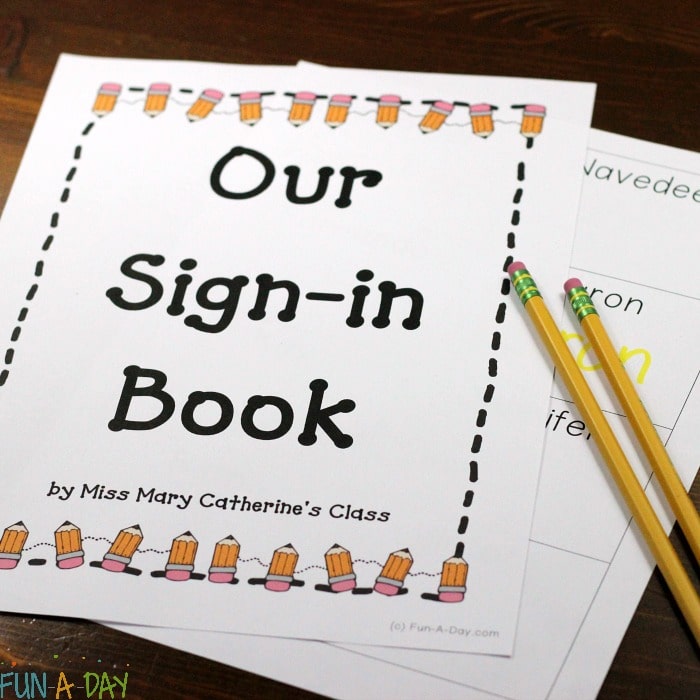
The sign-in book also allows me to keep a record of each child’s progress when it comes to name writing and recognition. I sometimes jot notes to myself in the margins of the book once the kids are done.
These notes might include comments about the children’s pencil grasp, if they wrote their name in order and left to right, or if they need more help with letter formation. At the end of the year, the sign in book shows each child’s name writing progress from the beginning of the year.
I love looking back through the book at different parts of the year. I look at how the children wrote their names the first week of school, and I usually compare that to how they’re writing in December, then February, then May.
In addition to helping me see the changes in their name writing, it’s also a helpful tool during parent conferences. Just break out the preschool sign in sheets and let the parents see what’s going on. Such a simple way to show parents what a great job their kiddos are doing in preschool!
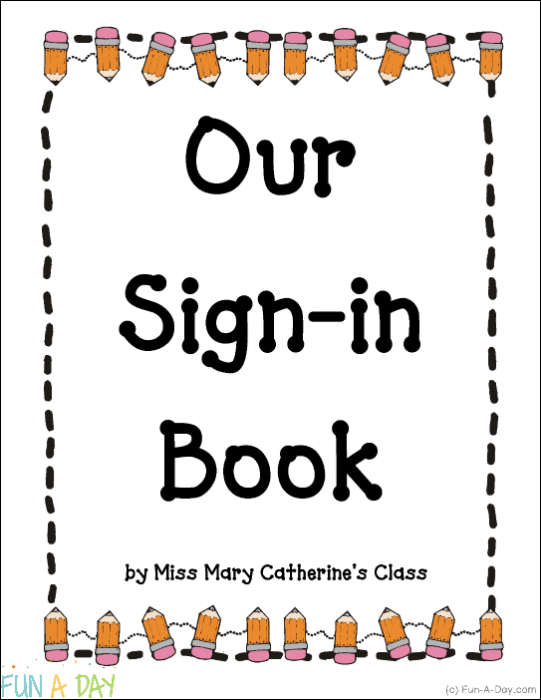
This super-simple classroom staple is so easy to create. It only requires a few items (I may get commissions for purchases made through links in this post):
*Optional, depending on how you use the book. See details below.
This sign-in book is pretty simple, and I like it that way! It has a front cover that says “Our Sign In Book”, and there’s a laminated back cover as well.
The front cover is printed out, mounted on colorful construction paper, and then run through the laminator. To make a back cover, I just laminate a second piece of construction paper. Take my word for it, if you want your sign-in book to last the year, make sure to laminate the front and back covers!
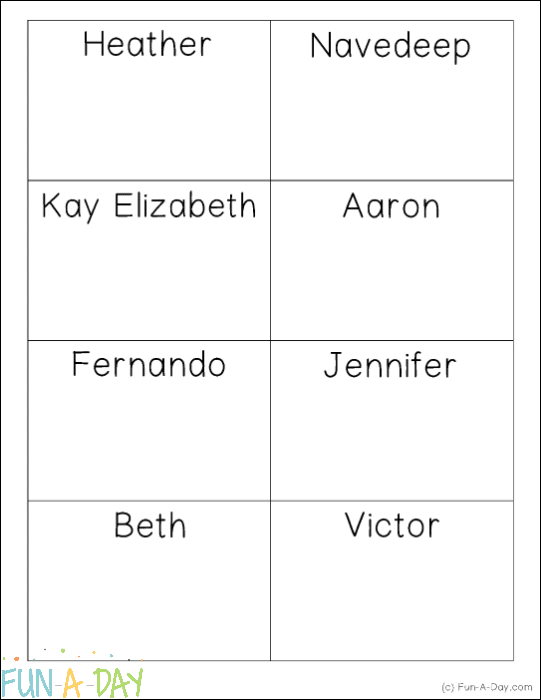
The actual sign in sheets themselves get placed between the covers, and everything’s held together with loose-leaf rings.
For the preschool sign in sheets, I use a very basic grid with 8 rectangles to house the students’ names. I usually just type it up in a Word document, but sometimes I simply write their names within the rectangles. The names are at the top of the rectangle, with room underneath for the kids to sign in.
Since it’s held together by loose-leaf rings, it’s easy to add more sign-in sheets as the year progresses.
You can grab your own free printable version of my sign-in book below. Bonus – it’s now editable!
At the very beginning of the year, many children are still learning the correct formation of their names. Because of this, I sometimes use a yellow marker to help them out.
Underneath the type-written name, I write the name again in the yellow marker. Then, when a child is signing in, he can trace over the letters I wrote in yellow.
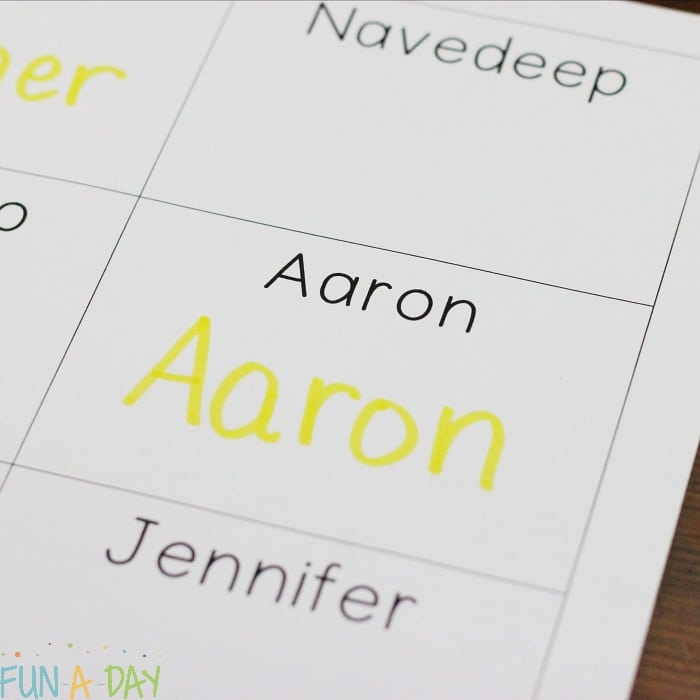
Much of the time, I am sitting next to the child, walking him through the name writing process. This includes moving from left to right when writing, and I also focus on the correct letter formation.
Despite how much detail I’m going into here, it really is a quick process. Some children need more help than others, and that’s perfectly fine!
If you are teaching your children or your students how to write their names, I would like to stress one point. PLEASE let the children see their names written with the first letter capitalized and the rest lowercase.
This is how they’ll usually write and see their names. Plus, they’ll need to write their names this way in elementary school, so why not do it this way from the start?
When I say this, I do NOT mean you should force the kids into it. Nor should you make them feel poorly if they’re not doing it correctly. I simply suggest that you have it written that way on the sign in sheets, model and explain how to do it, and encourage proper letter formation.
If they don’t write it that way . . . it’s okay. You’re exposing them to the concept by having it in print and modeling the way to do it.
Yes, I’m aware that this is a hotly contested topic in the early childhood field. To each her own, so let’s not fight about it if you disagree with me. We’re all working hard for our students!
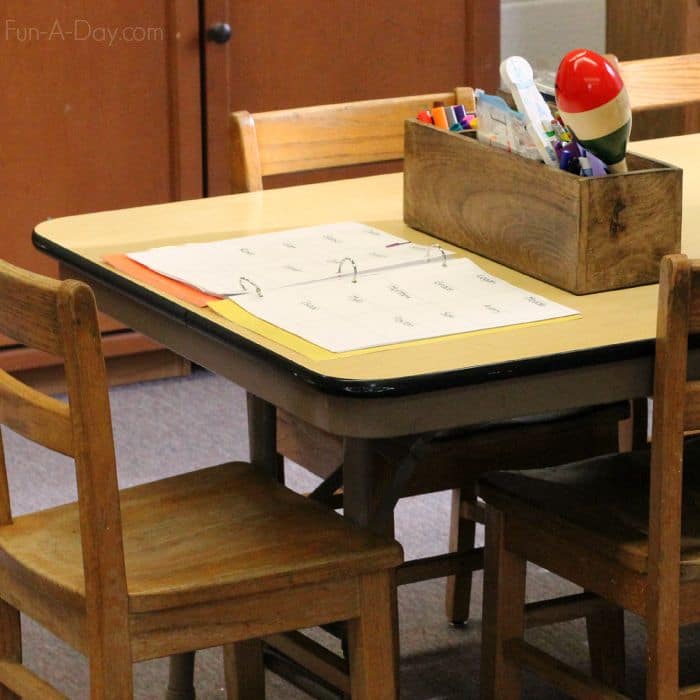
At the request of many of you sweet readers, I put together a printable to share. It’s available to members of Fun-A-Day’s email community. Enter your email in the form below to have the printable sent to your inbox. If you’re not a member yet, that’s okay! You can enter your information in the form to join us, and you’ll get the printable as a welcome gift.
You can also access the form in a new tab if you’d prefer.
It comes with a front cover, as well as multiple sign-in sheet pages. The cover and the name writing pages are editable so you can include your own class name, as well as the individual students’ names.
When you download the free printable, you’re agreeing to my my terms of use.
Do you use preschool sign in sheets or a sign in book in your early classroom? Do you find it’s beneficial for the kiddos? If you’ve never used one before, what do you think of the idea? I’d love to hear your thoughts in the comments below!
If you really want to be setup for a variety of sign-in possibilities, be sure to check out Preschool Teacher 101’s Editable Sign-In Name Pack!
Over 150 pages of editable sign-in sheets, as well as other ideas for preschool sign-in activities. Multiple sign-in formats AND there are even versions that allow you to upload children’s pictures!
PLUS you just add your class list once and the names are auto-populated throughout the sign-in pack. So you can then print out the pages your class needs with their names all ready to go.
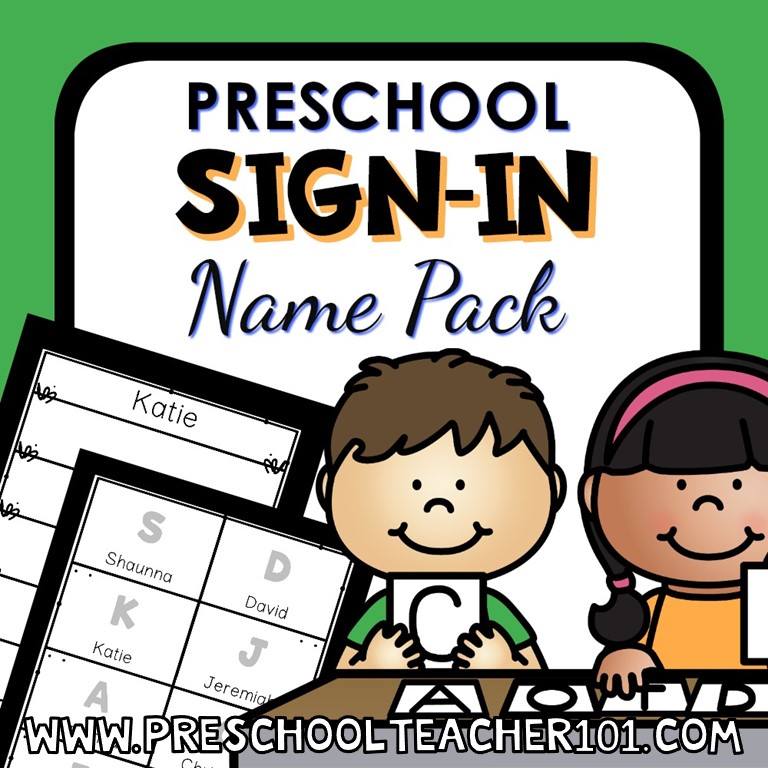
The sign-in book is just one of many strategies to help children learn to read and write their names. It’s also just one of many ways preschool children can sign into their classrooms. Here are more name activities to check out:
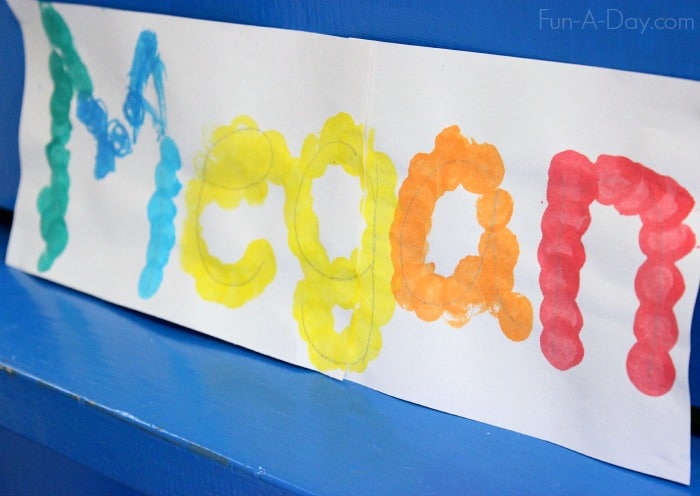
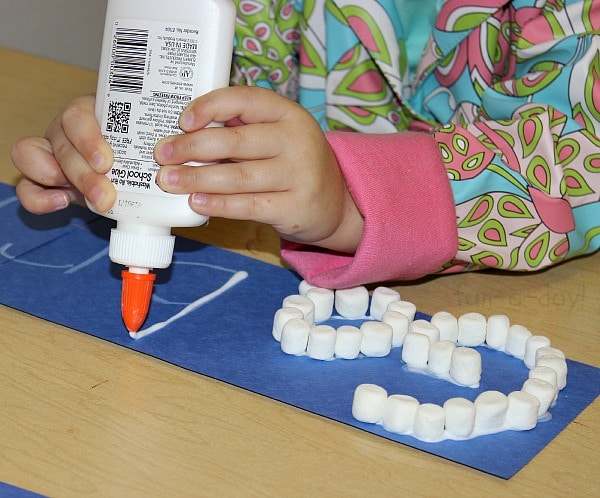
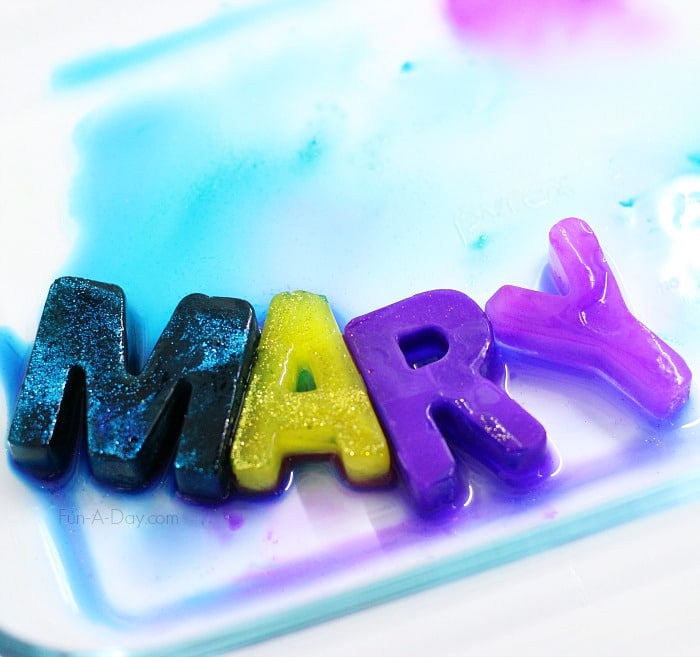
Originally published August 12, 2013.
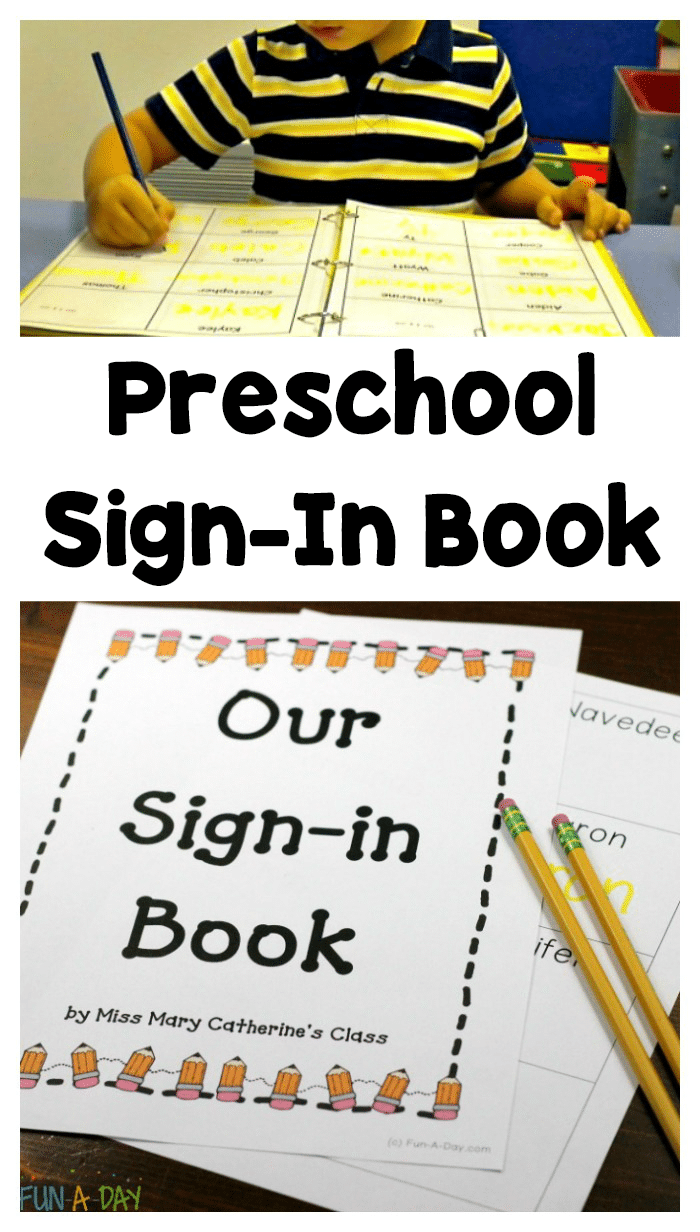
A sign in book/sheet is one of the ways I have had the kids sign into class. Thank you so much for the reminder to teach kids to print their names with a capital letter first, and then lower case. Kindergarten teachers everywhere thank you.
Thanks, Sandi! 🙂 I always felt SO bad for the kids in my K classes when they had to completely relearn how to write their names. I remember telling them they should be so excited to learn how to write their names so many different ways!
Thank You!. I’ve been using multiple versions of sign-in pages in my PreK classroom for years! But this one certainly fits the bill for this coming year! I may have one binder per table or even per student at the beginning to ease the flow. I’ll keep you posted on how it goes…
Oh, I’m so glad you find this useful for your preK class! I can’t wait to hear how it goes, and I’d love to know how you adapted it to better meet your needs!
Thanks for the idea of a binder at each table! I think we can do that!Thank you, Lisa!! Let me know if you try any of the name ideas with your kiddos! I always love to hear how things went with other children, as well as tips for improvements from other teachers. 🙂
Thanks for this great idea! It can lead (later in the year) to signing under a choice (when they don’t need to see a copy of their name any more) such as ‘ladybug’ or ‘butterfly’ which do you like better? I will also use artwork by famous artists for them to choose, or two books I’ve read. The program ‘Handwriting without Tears’ says that if they are just beginning to write their names, to use all caps first. If they already can print their names, then model the first letter in caps and the rest in lower case. Fine motor wise it is easier, they can transfer later when they are learning the lower case letters. FYI
Thanks, Kim! 🙂 Yes, that’s often what I move towards later in the year — signing in with graphs, polls, and even in different areas around the classroom. While I appreciate that many teachers find success using “Handwriting without Tears”, I strongly disagree with teaching all uppercase first. This is based on seeing so many children struggle to retrain their muscle memory when moving from all caps to writing their name in the usual fashion. I don’t think it’s actually easier fine motor wise, to be honest. There are ways to improve fine motor skills in so many ways anyway. I’d rather the kiddos take a little longer learning it correctly the first time. Again, I respect that others use and like the program, but I disagree with their take on this particular point.
I ues the “Hand writting without tears” program and we love it! Teachers and kids! However I also work very hard to teach the children to print their names with a capital and then lower case letters. Does that confuse them?! Not so far!
Glad to see some support for Handwriting Without Tears. I’m an Early Childhood Special Education teacher and my students have had incredible success with the program. To each his own though, and whatever works for your kids, use it!
I like the cove page. I give each child their own page with five lines for each day of the week and then I can send it home for parents to see their progress. Thanks for sharing!
Thanks, Andrea, I’m glad you like the cover page! Giving the kids their own pages sounds like a great idea, too. What a way to show parents their progress as well. 🙂
I love how you formatted this! We have a writing notebook in our class with sign in sheets, and I’m definitely going to add this one to the mix. I wrote a little bit about my writing notebook here: http://preschoolinspirations.com/2013/08/17/fun-ways-to-encourage-writing-in-young-children/
You can disagree with H.W.O.T.’s “take” but it is not developmentally appropriate to start with capital followed by lower case. When motor skill is stronger forming lower case letters will be a snap! 🙂
I have solid reasons for disagreeing with HWOT’s way of teaching letter writing, but I’m still looking to find research to indicate the developmental appropriateness of it. I’m always up for different views and opinions, but I am super interested in reading the research behind the other points of view. 🙂
Hi. I just found your sign-in book and we will use it for the remainder of the year. I also am not a fan of uppercase first. In fact, I don’t teach my preschool kiddos uppercase at all. The Spalding Method, which integrates phonemes with the correct way to form each letter, leads to learning to read much faster. Although my school doesn’t use the Spalding Method, I use those principles in teaching preschoolers to recognize, write, and know letter sounds. Thanks for the ideas and discussions!
Thanks so much for stopping by, DIane. Let me know how the sign-in book works with your kiddos! I appreciate the information about the Spalding Method as well. I’ll be looking into that soon — I love reading research and looking into different methods.
Thanks this is a wonderful idea. I m making one right nowI love this idea! Thanks so much. I’ve just made one and I am starting it tomorrow as my kids come back for Term 2.
Thanks for this idea! I am hoping to incorporate this, or something like it, in my Pre K class this school year. I teach half day Pre K, so I have 2 classes with 22 students each class. I am wondering how I could do this but save some trees, so to speak. Do you have any suggestions?
Thanks for the kind words, Jennifer! I print them double-sided which helps in terms of using less paper. You can also just use a notebook and write the kiddos’ names in there for them to reference and leave a spot to sign in. Hope that helps!
Jennifer, we laminate them, and have the kids use a dry erase marker. It doesnt show progress, but saves on trees 🙂
thanks for sharing! i have 30 pre kindergarten students daily. would you recommend putting all names in one book and having them flip through daily to find their names?
I’d say just go with whatever is going to be easiest for you and the kids. Are all 30 coming at one time? If so, then having multiple books might make the transition faster, as multiple children could sign in at the same time.
To save paper, you could use a plastic baseball card holder sheet and place their name inside the card pocket. The students would sign in with a dry erase marker daily. You could then use a paper copy once every couple weeks to track progress.
I teach life skills at the high school level for moderate to severe intellectually disabled students. I have had them sign in at the beginning of the day on a legal pad. I like your ideas, I will be incorporating them.
I am excited to use this in my PreK classroom! Is there a way to edit and type the students’ names at the top?
I teach Preschool (older 3’s and younger 4’s.) I have used a sign in book before. I find it to be very beneficial. You are able to show the child how much progress they’ve made at certain intervals (i.e. beginning of year, middle of year, and at the end of the year.) This helps build his/her self-esteem so they become even more excited about going onto the next class. You are able to access them and give praise for those little milestones…
I am always saddened for the students when I hear PK and K teachers speak about writing in Name Case in PK. It’s just not developmentally appropriate to expect tiny hands with underdeveloped muscles to manipulate a writing tool making curvy shapes. I have been teaching PK for over 30 years and even today, top developmentalists encourage beginning with CAPS which are mostly straight lines and, not only easier to ‘see’ but also easier to write. It is not our job as PK teachers have K expectations for our children. It is our job to meet them where they are and scaffold learning. Begin with CAPS, as their muscles develop and they are fluent in CAPS, scaffold and teach Name Case, introducing lower case letters when their hands are more adept at forming them. Read the research from Handwriting WIthout Tears, check best practices from NAEYC on muscle development. PLEASE, please stop telling PK teachers to force young children to do what they are not yet ready for.
Hi Jean, thanks very much for your input. To begin with, I am definitely not saying that children need to be forced into this. I believe they need to be exposed to their name written correctly and shown how to do it. I respectfully disagree regarding teaching in all caps. When done on a large scale, lowercase letters aren’t too much different than uppercase. The lines and movements align greatly between uppercase and lowercase in many ways. Again, thanks so much for your input even if it’s counter to mine. I appreciate your time and thoughts!
I’m in my 16th year as a pre school teacher…. You are right on about this! Thank you for saying it.The comment was for JeanB. I expose the children to their names with capital first with lowercase after….however i DO NOT expect them to write it that way …..my class is a mixed age class with varying degrees of fine motor proficiency and literacy capabilities. The children are seeing the letters presented all over the room in posters, signs, circletime letter cards, and Labeling with photos all around classroom etc. with both capitals and lowercase. Those ready in their heads to make the transition to using the upper and lowercase letters correctly will begin doing so in their own time
If one is easier to write than another so be it…. If the children connect the letters to the sounds, that is more important at this young stage in their lives. Respectfully yours,
C. LeFebvre (16yrs pre-k T.)
Thanks for adding your thoughts, C. That’s exactly what I do as well. As I mentioned above, I don’t force the issue (as I don’t think that’s appropriate at all). Showing them what their names look like with capital at the beginning and lowercase following is important, as is teaching them to write that way. I fear that some think I force the kids and make them erase and redo their names over if it’s not exactly right. That’s not the case at all! Some sign-in in all caps and that’s okay. But I think it’s important to show them what their names look like in the form they’ll see it most of their life. So it seems that you and I do the same thing.
Great idea, i love that. I’m gonna apply that in my school.thank you for such great ideas…Thanks so much! It honestly depends on each different group of kids. But it works very well within our daily schedule.
I love this idea. Our EC children sign in everyday at a slant board. Our class is comprised of all special needs children. At the top of the board, hanging on a clip, is a ring with each child’s name. As each child takes a turn, they find their name and then write their name. Each child is given the support neede to be successful. There is always someone at the easel to make sure correct letter formation is used. Most of our children are able to write their names by the time they move on to kindergarten.
What are the different ways you have to sign in. I live this,idea of a sign in book. We are restructuring our classroom next year and I’m going to use this then. Interested in knowing how you change it.
I do name tickets daily but love the idea of using a sign in book. It is always a bit tricky in the morning right when school begins. Could you explain your routine for how children sign into the Sign-In Book?
I love your name tickets idea as well! 🙂 Our morning routine has a few different steps for the kids. So if there’s already someone signing in, the children go about the rest of their routine until they have a chance to sign in. With larger classes, having 2 sign in books can make a difference.
I love, love this idea…I will be implementing this very soon. Thank you! 🙂I currently teach kindergarten and we have a sugn in book, too. The only thing I add is that they start sometime in the middle of the year writing last names and at the end using our lines to write their names. Thanks for your article for it helped justify my sign in book.
My children are going to be new 3 year olds with developmental delays. They are just learning to hold crayons, etc. Is it a good idea to have a sign in book? I do like the idea.
I like using the sign in book for older preschoolers (4/5 year olds). Prior to that, I’d focus on recognizing names, fine motor development, etc. For a sign in with younger kids, consider having their names already written on a piece of paper (or a cut out or a sentence strip). Then they can move their name to “school” when they come in and “home” when they are leaving. Something more along those lines, anyway.
Such a great idea! I will definitely use this one. Thank you for sharing.I think this is an aswesome idea! I will be trying it this upcoming academic year seems to have a lot of benefits. Thanks for sharing.
I had a sign in book last year in our preschool class. I used tabs for each kid so they have to find their tab and then sign in the rectangle. I can very easily see how much progress that child has made in his or her name writing. I also think it is a great one on one time with each child. The kids will notice how they are making certain letters better each time and make a comment.
Hi Kathleen! The writing table is separate from the art table, but sometimes the kids end up combining the two (which makes sense – they create art and then want to write about it). Supplies for the writing center — different types of paper, crayons, pencils, markers, stickers, stapler, hole punch, stencils (some alphabet, some pictures), stamps and stamping pads, clipboards, mini notebooks, magnadoodles, etc. Sensory writing trays are switched in and out at various times throughout the year, as are mini word walls related to the seasons or themes.
Each child in my classroom has a laminated 5×8 post card. The write their name using a dry erase marker. First name in on the front and last name is on the back. We erase these each morning before the children arrive. My children sign in every morning. How often do you have the children sign in? Does each child have to pull the sheet our every time to write their name? I’m a little confused on how your sign in works, however I do like the idea that you can see growth in the name writing.
Hi Diana! With the sign-in book, every child has a spot on one of the pages (like the pictures in the post), so we can leave it open and kids don’t need to flip through to find their names. I place the book out on the table and kids can sign in as they arrive. I place a paperclip on the day’s page (in case anyone shuffles the pages accidentally). I like the kids to sign in every morning, when possible. I also like to mix it up so that there are hands-on sign in ways and different materials used. But I like having the sign in book used at least a few times a week every week from the beginning to the end of the school year. You could definitely laminate the pages and make it more reusable too!
Love this idea. Any idea how to use it for kids who can’t write yet? 2’s and young 3’s? We need to have a sign in activity at my school. Most use something like taking their bird Cleo and adding it to the tree but I like this idea of them seeing their name and finding it.
That’s a great question, Sam. I like the idea of having the kids’ names written on something (like a bird or even a sentence strip piece). Then the younger kids take their name and move it somewhere that indicates they are here for the day. With the sign in book, having them find their names is a great start – we definitely don’t want kids who aren’t ready to use the books for writing their names. But perhaps having a washable ink pad nearby. So they can find their names and add their fingerprints by it?
LOVE this and can’t wait to use it for my class! However, I’m having trouble with the font. It doesn’t come up with the same font as the picture…which changes the “a’s” to a type font rather than the kid friendly “a’s”. Any ideas on how to fix it?
Hey Kim, thanks so much for the kind words. I can’t wait to hear how it goes with your class! I’ve got a printables FAQ help page here, but I’m betting that you’re running into this because either (a) you don’t have the most up-to-date version of Adobe Reader, or (b) you’re opening the printable in your computer’s default PDF reader (and it needs to be opened in Adobe Reader). Hope that helps.
I’m looking forward to using the sign in book! Thank you !Such a great way to approach signing in. I have used sign in sheets in my home daycare but I really like the style of yours and will be making a few three ring binders. Thank you so much for the great ideas. I also like the ideas down below for incorporating 2 year olds. I am breaking out the ink pads so they can add their finger prints. Thanks again.
Thanks so much for all the kind words, Paula! I’m glad to hear some of the ideas will work for you. 🙂
great what i was looking for!